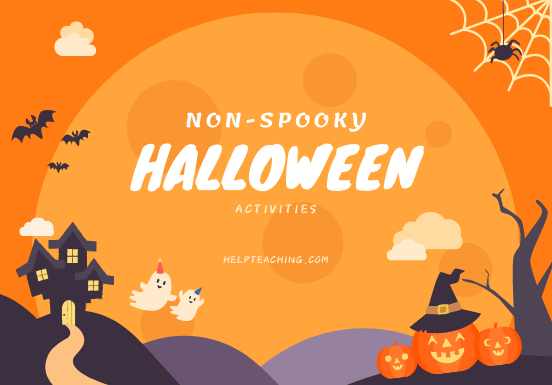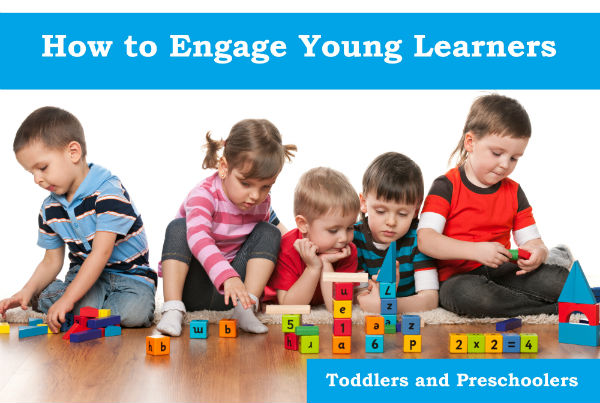Currently Browsing
Author Archive
Ultimate Guide to Educational Toys for Kids
- 25 November //
- Posted in For Parents, Teaching Resources //
- Tags : gifts, parent resources, ultimate guide
- Comments Off on Ultimate Guide to Educational Toys for Kids

Did you know it’s possible to have fun and learn at the same time? While it’s great for kids to play with toys, their young minds are at the prime stage for taking in information and learning new skills. The solution? Toys that allow kids to learn while they play. This year when you shop for holiday and birthday gifts, opt for something with educational value.
Need help finding ideas? We’ve rounded up some of the top educational toys for kids.
Disclosure: HelpTeaching partnered with the companies of some our top picks to provide items for a giveaway, but all items were chosen for their quality educational value.
|
JUMP TO:
|
Babies | Toddlers | Preschoolers |
| Early Elementary | Upper Elementary | ||
| Pre-Teens | Teens |
Babies
Even though babies won’t remember whether you bought them a gift for Christmas or their birthday, sometimes you still want to get them something. Instead of adding another stuffed animal to their collection, try one of these options.
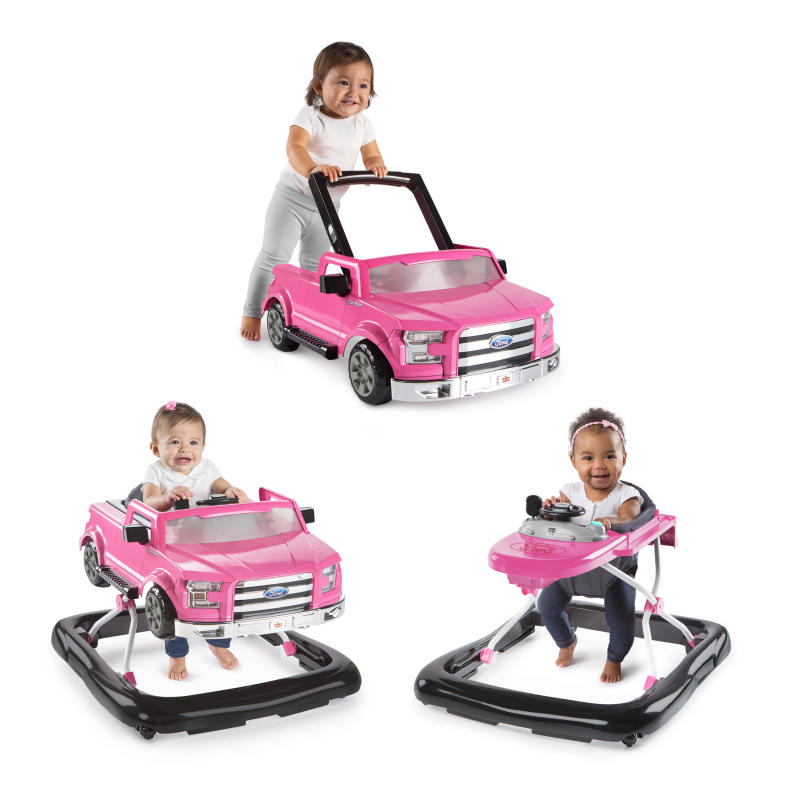
TOP PICK: 3 Ways to Play Walker – Ford F-150 – Never underestimate the power of observation. This walker allows babies to explore the world around them in three different ways, including a normal walker and push-behind mode. The steering wheel and authentic truck sounds and lights make the walker even more adorable.
Baby’s First Blocks: Nothing beats a classic shape sorting toy for babies and toddlers. Baby’s First Blocks from Fisher-Price features a handy tub to collect the shapes and a handle for carrying it. Babies and toddlers will learn to grab, manipulate, and match the shapes.
Skip Hop Activity Mirror: Mirrors are great toys for babies. They allow them to explore the world around them and also begin to recognize their own face. This mirror from Skip Hop is just one of many baby mirrors that can be attached to the seat of a car or the bar of a stroller for babies to enjoy.

Munchkin Mozart Magic Cube: Babies love music and this magic cube combines music with lessons in cause and effect and tempo to create a fun learning experience for babies. They can press different parts of the cube to add instruments to the orchestra and see lights flash with the tempo of the music.
Go Car: This car comes with a handle to make it easy for babies to hold on to it and control the way it moves. It also glides smoothly on different surfaces, helping babies begin to learn about the concept of movement.
What’s Inside Toy Box?: With the What’s Inside Toy Box, babies begin to learn that objects have names and also build motor skills as they reach in and pull out objects or put objects back in. Additionally, this toy can help teach object permanence.
All About Me Personalized Photo Book: Babies can learn the names and faces of loved ones, pets, and other special people or places in their lives with this photo book. Parents can insert photographs in protected compartments so babies can flip through and look at them.
Toddlers
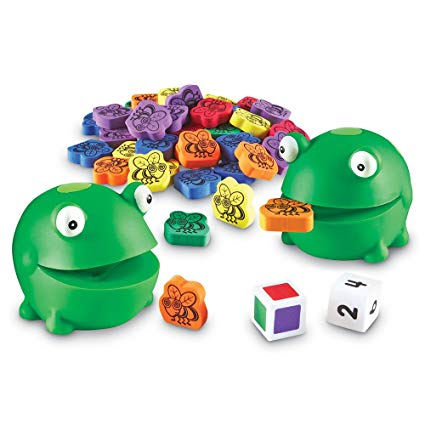
TOP PICK: Froggy Feeding Fun – Little kids can boost their fine motor skills, learn their colors, and practice their counting skills with this fun frog feeding game. Simply roll the dice and feed the frogs the correct flies. Note that the fly pieces may present a choking hazard so kids should be supervised while playing.
Start-Up Circuits: Toddlers who enjoy playing with switches will enjoy these toys that help them begin to understand how circuits work. Simply flip the switch to make each object work.
Wooden Building Blocks: Blocks are a favorite for toddlers because they help them build motor skills and begin to understand geometrical concepts. This set from Pidoko Kids features 50 colorful blocks in different shapes and comes with a container for carrying them all.
Personalized Name Puzzle: One of the first things a toddler learns how to spell is his/her name. Help develop that skill and help your toddler start learning how to complete puzzles with a personalized name puzzle.
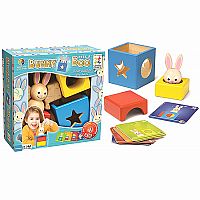
Color Discovery Boxes: Color Discovery Boxes help toddlers learn their colors and begin to categorize objects. Each box contains multiple objects to represent the color. Mix the objects up and have toddlers sort them and put them back where they belong.
Bunny Peek a Boo: This fun game helps toddlers learn about prepositions and object placement. They must look at the cards and try to create the scene with the bunny and various blocks. Parents are encouraged to give clues and talk about where the bunny is. For example, “The bunny is behind the box.”
Learn the Alphabet Dough Mats: You can print out and laminate your own dough mats or you can buy these handy mats which feature uppercase and lowercase letters. These help kids learn letters and build fine motor skills.
Size and Sequence Farm Puzzles: Size and Sequence Farm Puzzles have toddlers put the puzzle pieces in order by size. This set of puzzles helps them learn how to organize objects from smallest to largest.
Dress-Up Career Set: Toddlers can learn a lot from dressing up, especially when they dress up to represent different careers. With this set, your toddler can pretend to be someone else nearly every day of the week.
Seek A Boo: Seek A Boo is a fun game designed to get toddlers and preschoolers moving and help them learn how to categorize objects. Basically, it works like a game of “I Spy” where kids must find a circle that meets a particular description. Adults and kids can take turns coming up with questions.
Preschoolers
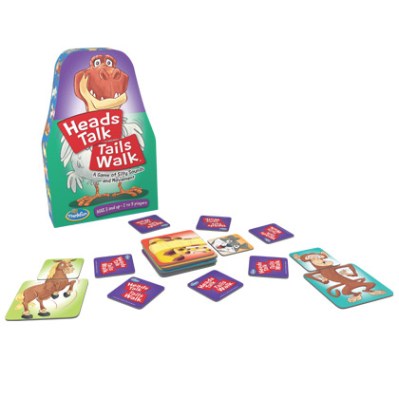
TOP PICK: Heads Talk Tails Walk – ThinkFun’s game of silly sounds and movement has kids try to match hidden head cards to the correct bodies. If the body parts don’t match, kids have to try and act out their crazy new animals.
Yeti Forgetti Memory Game – This hide and peek memory game gets kids in on the action. Cards direct kids to shuffle the igloos and try to find the locations of the different yetis in the game while watching out for the evil snow crab for a twist on a classic shell game.
Bear Counters: Bear Counters and counting cubes can be used by preschoolers in a variety of ways. Not only are they good for counting practice, but they can also be used for creating patterns and measuring.

Fun Express Happy Kids Hand Puppets: This adorable set of hand puppets features kids from different ethnic backgrounds. It’s great to include with a puppet theater and to use to act out social stories to help get preschoolers thinking about their actions and emotions.
Toss Across: If you’re looking for a fun game to get kids moving, try Toss Across, a game that helps kids practice their throwing skills and learn about patterns while playing a game of tic tac toe.
Periodic Table Blocks: Make block play a little more educational by having kids learn the elements of the periodic table at the same time. These square blocks are great for building and also feature the names, symbols, and atomic numbers of various elements.
Mosaic Mysteries Pattern Puzzle: Kids can build fine motor skills and create patterns when they play with the Mosaic Mysteries Pattern Puzzle, an activity that features connecting tiles to create a mosaic.
Early Elementary
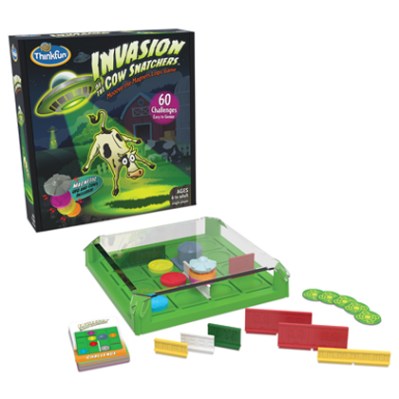
TOP PICK: Invasion of the Cow Snatchers – Kids can build their logic and problem-solving skills with this exciting STEM game from ThinkFun. While the game can be enjoyed by kids as young as 6, even older kids, teens, and adults will enjoy trying to solve some of the genius-level challenges.
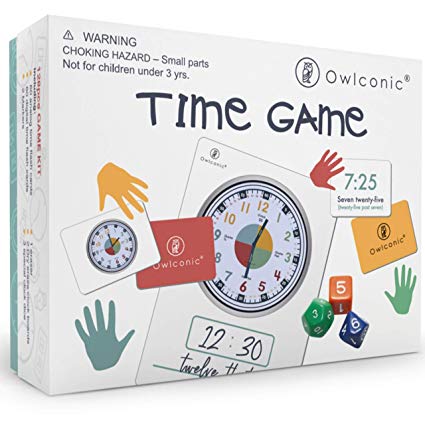
TOP PICK: Owlconic Telling Time Teaching Game – For teachers and homeschool parents looking for new ways to help kids learn to tell time, this telling time game is exactly what you need. It helps kids make connections between digital and analog time while also working on memory skills and fractions.
Teaching Talking Cash Register: This cash register is a favorite of kids because it offers many functions. Kids can play store or open a real store and the cash register will help them add up totals and calculate change. It also features a fun scanner.
Melissa and Doug Magnetic Human Body: Kids can learn the different parts of the human body by taking them on and off the wooden form. It’s a great, non-gory way for kids to begin to explore what makes up the body.
Magformers: Magformers feature fun tiles that connect to one another. Kids can use them to build unique structures.
Magnetic Science: Magnetic Science contains 38 pieces to help kids explore magnets and their various uses.

Precision School Balance: With a balance, kids can practice weighing items and comparing different weights. For example, is a carrot heavier than four quarters?
Dive into Shapes: Using a series of rods and balls, kids can build their understanding of geometry as they try to recreate the shapes on the cards.
Sum Swamp: Sum Swamp is a fun game that helps kids build their addition and subtraction skills.
Paper Airplane Conversion Kit: With the help of a grown-up, kids can use this kit to make a variety of paper planes and see how long they fly electronically.
Beaker Creatures: Learning Resources has created a fun science toy where kids can conduct experiments to reveal hidden creatures. Kids simply pop a reactor pod into the chamber, complete the steps, and discover a surprise. They learn about the scientific method and follow directions at the same time.
Upper Elementary

TOP PICK: Squishy Human Body – SmartLab Toys helps kids explore the body through this unique model. The body includes 21 vital organs, bones, and body parts, as well as a 24-page anatomy book and other resources to help kids explore the model.
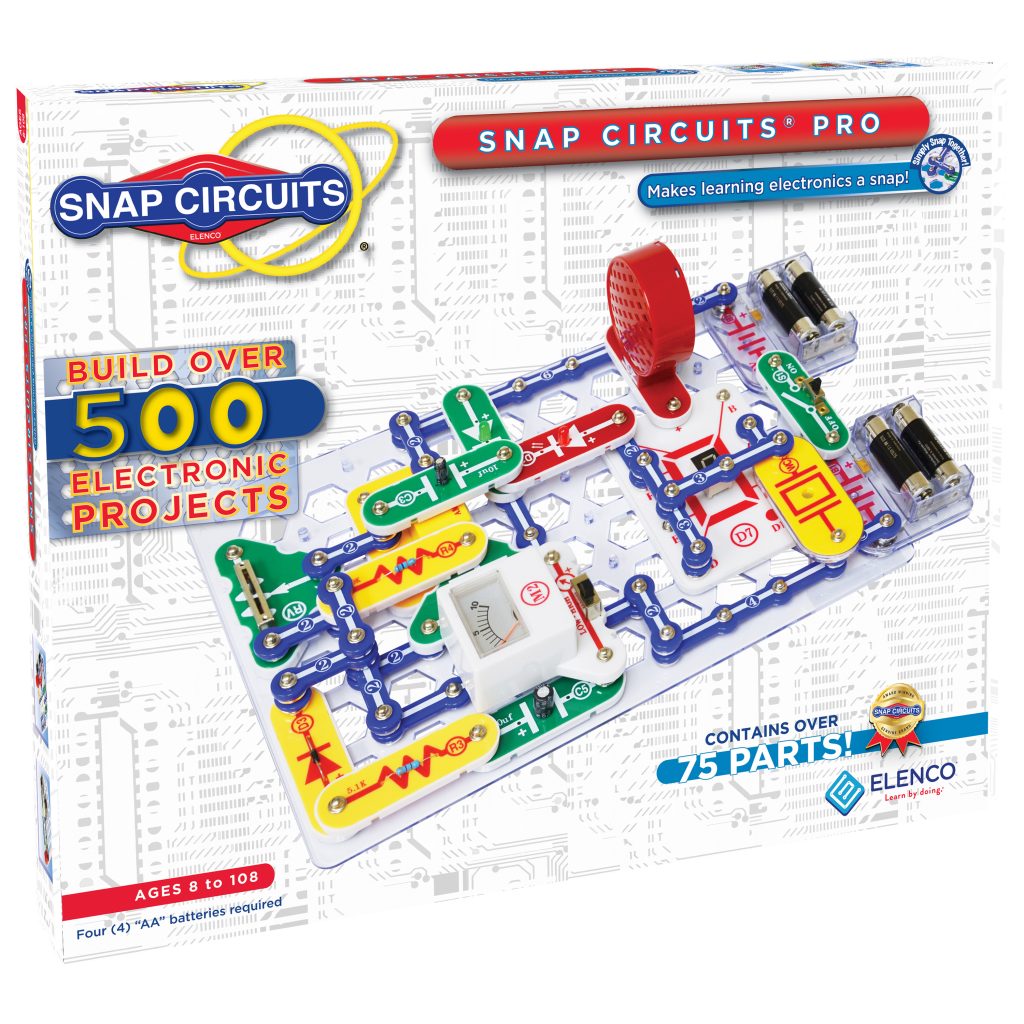
TOP PICK: Snap Circuits Pro – With over 75 snap-together parts and 500 exciting projects to complete, kids can learn all about electronic circuits and the basics of electricity. This kit is great for building STEM, problem-solving, and logic skills.
Adopt an Animal: Start teaching your child about giving back and becoming more aware of the world by adopting an animal. The kit comes with a certificate and a stuffed animal.
Kiwi Crate offers maker kits for kids up to age 16. Try Doodle or Tinker Crate for ages 9-16 and Kiwi for ages 5-8. Sign up for a monthly subscription box. Each box comes with fun STEM and STEAM activities for kids.
Tin Can Robot: Take an ordinary tin can and turn it into something cool with the Tin Can Robot kit. Using this kit, kids can build their own robot.
Star Wars Death Star Electronic Lab: Star Wars fans will love the challenge of the Death star Electronic Lab which has them connect circuits to help bring the Death Star to life.
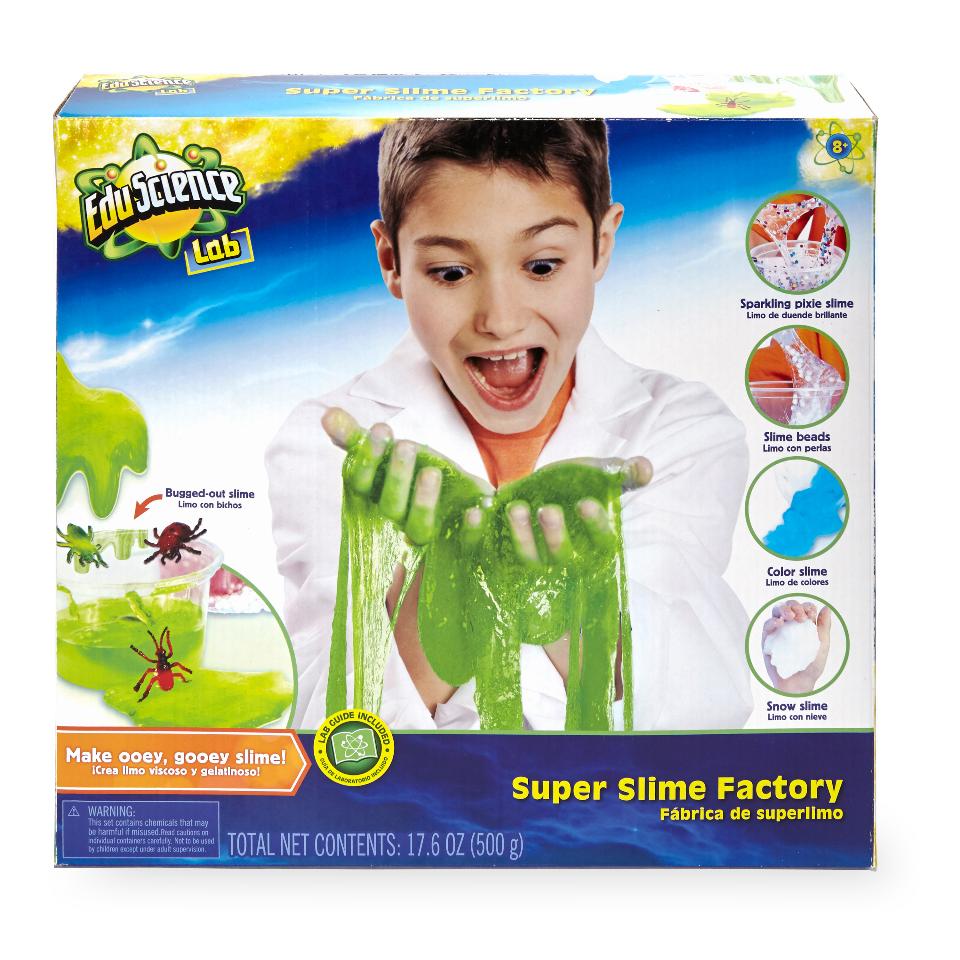
Super Slime Factory: Slime is all the rage these days and the Super Slime Factory gives kids the chance to make their own slime while learning a bit about the science that goes into the process.
Qwirkle: Qwirkle is a fun game with a dominoes-like feel. Kids must match the shapes and colors, but they also have to use a bit of strategy to win the game.
Keva Contraptions: With Keva, kids can learn about engineering and geometry. This set allows kids to build unique contraptions and also comes with two balls. Perhaps kids will use them to make an epic marble run.
Create a Maze: With the Create-a-Maze set, kids are tasked with re-creating the maze on a card and then trying to get a ball through the maze.
Klutz LEGO Chain Reactions Craft Kit: This book and LEGO set helps kids learn how to build simple machines and put them to use, introducing them to the laws of physics at the same time.
For preschoolers through upper elementary school students, you can also put together a craft kit, full of supplies, such as googly eyes, stickers, craft sticks, and glitter glue, to make a variety of crafts and to encourage kids to use their imaginations.
Pre-Teens
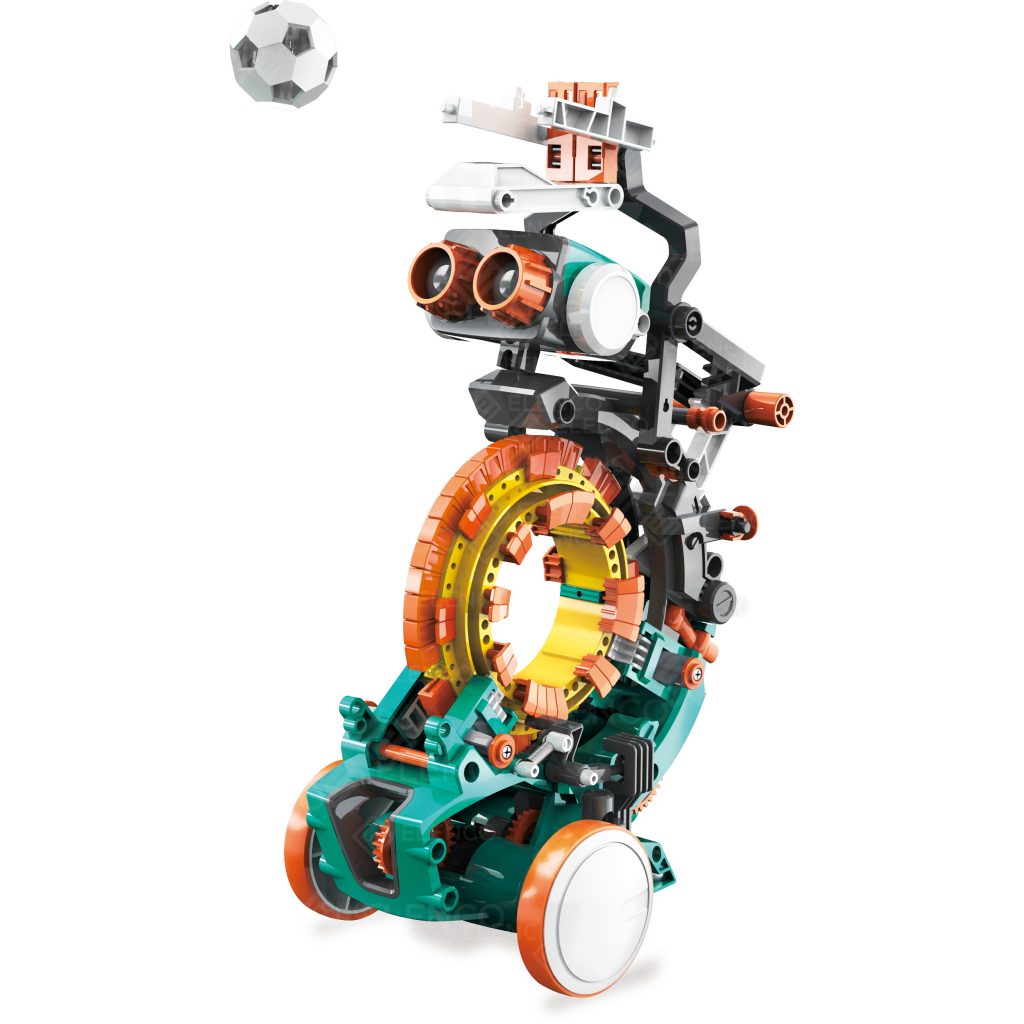
TOP PICK: Elenco Teach Tech Mech-5 Coding Robot – This STEM coding robot introduces kids and teens to the principles of mechanical engineering. They work with their robot to get it to perform tasks such as kicking, throwing, lifting, and even drawing.
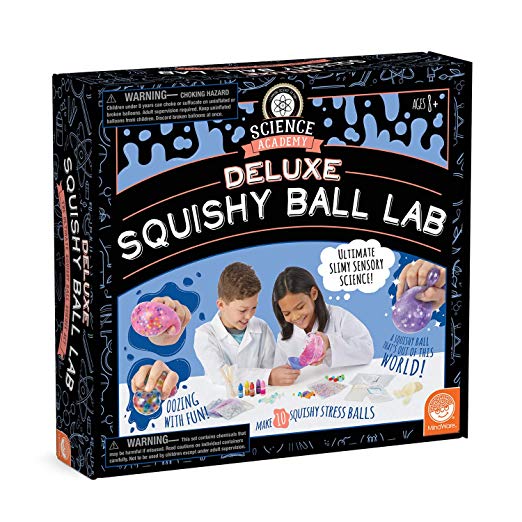
TOP PICK: Science Academy Deluxe Squishy Ball Lab – Encourage kids and tweens to get their hands dirty and make their own squishy stress balls. The kit is great for boosting STEM skills and getting in some sensory fun.
Kano Computer: Pre-teens who enjoy coding and working with electronics, but are not quite ready to work on a full-fledged computer will appreciate Kano Computer, which allows them to build their own mini-computer.
Perfume Maker: A lot of science goes into the creation of perfume. This set allows pre-teens to make their own scents while learning at the same time.
Spa Soaps Kit: Let pre-teens make their own spa soaps, and then use them to host a spa party for their friends. Better yet, they can package their soaps and give them as gifts to others.
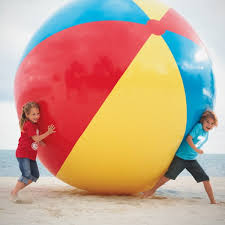
Giant Inflatable Ball: Encourage pre-teens to get outside and be active by purchasing a giant inflatable ball. They can make up their own fun games to go with the ball too.
Boxed Book Sets : If you know a pre-teen loves to read or has a favorite series, consider purchasing a boxed set. The Giver trilogy by Lois Lowry is a great set to consider.
Eco-Friendly Bean Bag: Instead of a normal bean bag, opt for an eco-friendly bean bag. The gift will teach pre-teens about being more environmentally conscious.
Build Your Own Pinball: Kids and teens can learn about engineering by building their own pinball game with this fun set.
Teens

Displates: Give teens a unique gift that teaches them to value creativity and different art forms. Displates come in different styles and relate to interests such as popular movies and TV shows or musical instruments.
Ion: A Compound Building Game – Know a teen struggling with chemistry? Find some STEM fun and refresh that chem knowledge with a fun game that has kids and teens collect cards and build chemical compounds.
Quadcopter: What’s more fun than a drone? A drone with a camera. Teens can make their own videos and take pictures as they fly their drones.
Marvel Puzzle: Have a superhero fan? Give them a superhero puzzle so they can enjoy some of their favorite skills and they put their puzzle-solving skills to the test.

Codenames Disney: Codenames is a fun word association game. Purchase the Disney version or another themed-version and play it with your teen.
Die Cast Spirograph: Spirograph may seem like a kids’ toy, but this version of the classic drawing kit is super sleek. Teens may find creating their own spiral shapes relaxing.
Games: World of Puzzles: Purchase a subscription to a magazine such as Games: World of Puzzles. This fun magazine includes many different puzzles for teens and adults to solve.
Game of Phones: Teens are always on their phones. Get them to interact with one another with this fun game which has them use their phones to send messages and complete challenges.
My Cinema Lightbox: A lightbox is a fun way to get teens to write. They can come up with creative messages or even practice spelling vocabulary words.
In addition to the gifts listed above, consider purchasing apps and other digital gifts for teens or giving them a gift card to purchase music and apps for their phones or tablets.
Do you know of any must-have educational gifts for kids or teens? If so, we’d love to hear your ideas. Share them in the comments!
*This list may contain affiliate links and some companies provided products for review, but all views expressed are our own.
If you enjoyed this read, you might also like what KidsKonnect has to say. Check out their articles today.
Alternative Thanksgiving Traditions
- 19 November //
- Posted in For Parents, Teaching Resources //
- Tags : thanksgiving
- Comments Off on Alternative Thanksgiving Traditions

Whether you don’t have family nearby or are tired of the traditional turkey and stuffing, this is the year to try something new. From celebrating friends to participating in a 5K, there are many different ways to celebrate this Thanksgiving. Who knows? These alternative thanksgiving traditions could become your or your children’s traditions for years to come.
Here’s our list of Alternative Thanksgiving Traditions:
Celebrate Friendsgiving
Instead of shelling out hundreds of dollars to travel home or eating a TV dinner alone, gather together some friends for a Friendsgiving. A Friendsgiving is typically celebrated on the day before or the day after Thanksgiving, but you can also celebrate it on the actual day. The goal is to gather together with friends and enjoy a meal together.
A traditional Friendsgiving works similar to a potluck. One friend agrees to host and provide the turkey, chicken or ham. The other guests bring side dishes and desserts. If you’re not much of a cook, store-bought dishes are completely acceptable. You could even all go in together and purchase a full Thanksgiving dinner from your local grocery store or favorite restaurant.
For a unique take on a Thanksgiving meal, try a progressive dinner where a different friend hosts each course of the meal. This works particularly well if you all live close together. If no one has the space to host, head to a local diner or a restaurant like Denny’s (as declared in Tim Allen’s The Santa Clause, they’re always open).
Give Back to Others
Instead of eating at home on Thanksgiving, spend some time giving back to others. You can go the traditional service route and sign up to serve Thanksgiving dinner at a local soup kitchen or try something a little different. Giving back also teaches kids an important lesson about the value of serving others and may help them realize they have a lot to be thankful for. Some ways to give back to others on Thanksgiving include:
- Deliver food boxes or turkey dinners to people in need
- Collecting holiday gifts for children
- Put together care packages to send to members of the military
- Send cards to people you miss
- Visit a local nursing home
- Provide a treat to the staff at a local hospital
- Go to a restaurant and leave your server a large tip
- Clean out your cupboards to gather food for a local food pantry
- Contact a local college and offer to host students who stayed on campus during the holidays
Get Fit
On Thanksgiving morning, thousands of people gather to participate in “Turkey Trots” around the United States. These 5Ks have become a Thanksgiving tradition of their own. Gather some friends together and enter the race together or run solo and meet new friends along the route. Many 5Ks also have special fun runs or walks, so kids can join in the fun too. If you’re not a fan of running, you can always walk the 5K or volunteer to help out with the race in another way. When the race is over, treat yourself to a hearty Thanksgiving meal.
If you’re missing your family’s annual touch football game, organize one of your own. Meet your friends at a local park or advertise the game on a local events page so others without family in the area can join you.
Have a Movie Marathon
Thanksgiving is a big day for movie releases. Head to your local movie theater and spend the day hopping from theater to theater to enjoy them all. Just be sure you purchase a ticket for each movie. If you prefer a cheaper option, invite some friends to your house for a Christmas movie marathon or a showing of “A Charlie Brown Thanksgiving.” If kids are included, pull out all of your old holiday favorites, such as “Rudolph the Red-Nosed Reindeer” and “Frosty the Snowman.”
Go International
Many other countries celebrate their own versions of Thanksgiving throughout the year. Introducing elements of other cultures can also turn itno a mini-geography lesson for kids. Consider adopting one of these traditions for Thanksgiving:
- In Jewish culture, some families build a hut from branches called a Sukkot. Then they eat a meal beneath the hut.
- In China, families enjoy mooncakes, filled flaky pastries. The cakes were often used to deliver secret messages.
- In Korea, families honor the deceased. They hold a memorial service and occasionally visit a graveyard before feasting on Songpyeon.
- In Liberia, chicken and mashed cassavas replace turkey and mashed potatoes on the Thanksgiving table.
- In Ancient Rome, citizens celebrated Ceres, the goddess of corn. Ceres is also where we get the word cereal, so perhaps you could incorporate some sugary cereal into your Thanksgiving meal.
However you decide to celebrate Thanksgiving this year, take some time to write down what you’re thankful for. One thing is for sure – we’re thankful for you!
Do you have any alternative Thanksgiving traditions? Share them in the comments!
Further Reading for Alternative Thanksgiving Traditions
15 Engaging and Eduational Acitivities for Fall
If you enjoyed this read, you might also like what KidsKonnect has to say. Check out their articles today.
Non-Spooky Halloween Activities
- 20 October //
- Posted in Fun Facts //
- Tags : activities for children
- Comments Off on Non-Spooky Halloween Activities

For kids who are traumatized or dislike ghosts, ghouls, and skeletons, Halloween can be a rough season. It’s hard to know what’s lurking around the corner at pumpkin patches, corn mazes, trunk or treats, and even the local grocery store. Still, that doesn’t mean you have to skip Halloween altogether. There are plenty of ways to celebrate Halloween without bringing in the darker side of the season. Here’s our list of non-spooky Halloween activities you can try this year.
1. Paint pumpkins
For some kids, carving pumpkins can be too spooky, especially with their crazy faces, but what’s stopping you from painting a pumpkin? Choose some bright colors and focus on funny faces or cute patterns, such as dots and stripes.
2. Bob for apples
If you’re having a Halloween party, throw in a traditional bobbing for apples game. While it may not be the most hygienic, kids will have fun trying to capture the apples with their mouths.
3. Watch a pet parade
Check your local newspaper or activity guide for a pet costume parade. These parades are usually free from spooky costumes and, instead, focus on adorable animals in silly costumes.
4. Head to a fall festival
Many fall festivals are held during the day and focus on the fun side of the season. To ensure the festival will be free from spookiness, consider attending one sponsored by a church where it’s less likely that ghosts, skeletons, guts, and gore will make an appearance.
5. Read a cute Halloween story
Read a story such as The Legend of Spookley the Square Pumpkin which focuses more on accepting your differences and fitting in than trying to scare kids on Halloween. Another cute Halloween book is Pumpkin Cat by Anne Mortimer. Elementary Librarian has a great list of Halloween read-alouds for more ideas.
6. Hold a non-spooky costume party
Invite some friends over for a costume party where only fun, happy costumes are allowed. Consider coming up with a theme, such as favorite cartoon characters or storybook characters.
7. Trick or treat with friends and family
Rather than going trick or treating around your neighborhood, set up a time where you can trick or treat at the homes of different friends and family members. Do it during the day so you won’t see any scary masks or other costumed people out and about.
8. Have Halloween craft time
Rather than making a spooky bat, Frankenstein, or other scary craft, just pull out some orange and black paint and construction paper, along with some glue and googly eyes, and let kids come up with their own creations.
9. Make silly monsters
Monsters don’t have to be scary. Focus on crafting monsters with silly faces rather than scary ones. You can give them cute names too.
10. Create leaf art
Go outside and gather some leaves. Make leaf creatures by adding eyes, noses, arms, and legs or use the leaves to make collages and other fun pictures.
11. Paint with a pumpkin
Cut out different shapes from a pumpkin and use those shapes as stamps. Dip them in paint and press them on paper to create unique works of art.
12. Make slime
Slime is often associated with Halloween, but that doesn’t mean it has to be spooky. Make or buy some slime and have fun getting your hands messy.
13. Play in a sensory bin
Slowly introduce kids to some of the spookier aspects of Halloween through a themed sensory bin. You can throw in a few small plastic bats, ghosts, or spiders if your child can handle them in small doses. You may also want to add plastic pumpkins, some dirt, or black beans. For extra texture, add some orange or black water beads.
14. Go on a candy hunt
One of the best parts of Halloween is getting to trick or treat, but you don’t have to find candy in traditional ways. Hide candy around your house or in your yard and send kids on a fun scavenger hunt to find it or set up different trick or treat stations in each room of your house.
15. Focus on educational activities
Try Help Teaching’s 100 Educational Pumpkin Activities to bring math, science, and literacy practice to the holiday.
If you do decide to head out to some more traditional Halloween events, be sure to call beforehand to see if there will be any spooky elements there and walk ahead of your child in any corn mazes or on any paths so you can be prepared to turn around if any scary elements appear. You may also want to bring along some headphones or a pair of sunglasses to help your child tune out the spooky sights and sounds.
8 Reasons Why I Teach Banned Books… and You Should Too
- 15 September //
- Posted in For Parents, Teaching Resources //
- Tags : books, language arts
- Comments Off on 8 Reasons Why I Teach Banned Books… and You Should Too
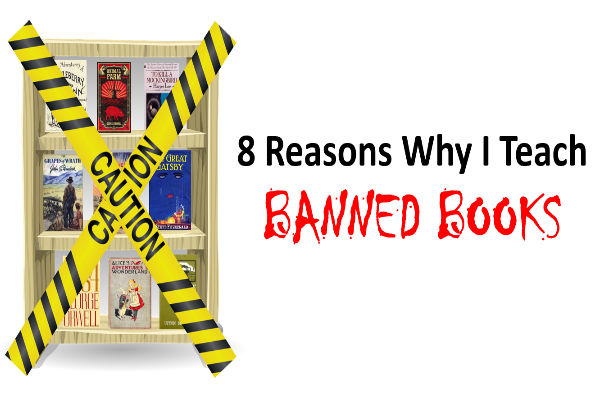
It seems like every year a new book makes the news for being challenged or banned by a school. Books that have been banned run the gamut from Mark Twain’s Huckleberry Finn to The Holy Bible. While some parents and teachers have legitimate concerns, others have less valid reasons (a library patron in Toronto, Canada wanted to ban Hop on Pop because it encouraged children to use violence against their fathers). Regardless of whether books contain controversial content, they should still be accessible to students. Here are eight reasons why I teach banned books and why they should be accessible to students.
Why teach banned books: They Challenge Students to Consider Alternate Viewpoints
As a parent, your first instinct is often to shield your children from things you don’t want them to see, but you can’t hide the world from your children forever. Banned books are often challenged because they contain controversial content or don’t mesh with adults’ beliefs, but that doesn’t always mean they’re bad. Instead of simply banning a book that contains an alternate viewpoint, use the book as an opportunity to safely expose students to that viewpoint. While reading the book, use reading response activities to discuss what’s controversial about it and why people might disagree with the actions or viewpoints held in the book. If you’re a parent whose child has to read a book for school that you don’t agree with, read the book with your child and talk to him/her about the content. Explain to your child why you don’t agree with it and encourage your child to share his/her thoughts too.
They Introduce Students to Diverse Characters
Often children live in their own little world where their friends and family members largely think and act like they do. While there are some exceptions to this rule, most children don’t get the opportunity to experience people and places that aren’t familiar to them. Many books have been banned throughout history because they contain diverse characters that children may not have encountered before. For example, the book Nasreen’s Secret School: A True Story from Afghanistan was challenged because the main character says a prayer to Allah in the book and the picture book And Tango Makes Three was challenged because the main characters are two male penguins who raise a chick together.
It’s important to remember that reading a book with diverse characters doesn’t mean you support those characters’ lifestyles or thoughts. Reading books with diverse characters can help students understand the different types of people that exist in the world and help them better prepare to interact with those people when they encounter them.
They Take Students Out of their Comfort Zone
Why are most books banned? Some of the most common reasons are because they include:
- racial themes
- alternative lifestyles
- inappropriate language
- unpopular religious views
- sexual or violent content
- unpopular political views
- references to witchcraft or the occult
- characters doing drugs or smoking
All of these reasons for banning books have one thing in common: they make people uncomfortable. It’s not fun to feel uncomfortable. It’s not fun to read something that takes you out of your comfort zone or challenges you to look at a situation differently, but it happens a lot in life and it’s bound to happen to children at one point or another. Should third graders be required to read books that contain excessive violence or sexual references? No. Should an eleventh or twelfth grader? Maybe. Because the eleventh or twelfth grader is about to enter a world where these issues will appear and what better place to practice being taken out of your comfort zone than in the safety of the classroom or your own home?
They Teach Valuable Lessons
In addition to taking children out of their comfort zones, banned books can often teach valuable lessons about identity, tolerance, or even freedom. For example, the book The Art of Racing in the Rain teaches readers a valuable lesson about the grieving process. The book The Working Poor: Invisible in America teaches a lesson about the real problems the working poor in America face. Brave New World teaches students about the extremes of passion and offers a bleak view of the future that students can connect to the future of the world. The Adventures of Huckleberry Finn has been banned numerous times its use of the n word, despite being regarded as one of the most valuable pieces of American literature.
They Can Be Interpreted in Multiple Ways
A book that is banned in one school or district may be perfectly acceptable in another. Take the case of Hop on Pop. One person in Toronto thought it advocated violence against fathers, but how many others have read the book and seen something completely different. What about the book And Tango Makes Three? Are children likely to see it as more than a story about a family of penguins? You could write a book with nothing offensive in it and, as a adults, we are often more likely to find offensive content than children.
They May Be Banned for Silly Reasons
Sometimes this also leads to books being banned for silly reasons. Did you know Shel Silverstein’s A Light in the Attic was once banned in an elementary school because it encouraged children to break dishes instead of dry them? The popular Harriet the Spy was once banned because Harriet is a spy and being a spy means that she occasionally lies and gets into mischief. Are You There God? It’s Me, Margaret was banned because it talked about a girl getting her period. Brown Bear, Brown Bear, What Do You See? by Bill Martin was banned because an author with the same name wrote a book about Marxism. Before you turn down a book because it has been banned, consider the reason it was banned. You may realize you were avoiding a book for no good reason at all.
They Are Often Great Books
Frankly, no one takes the time to ban a bad book. Not usually anyway. Books become banned because they become popular and fall into the hands of a diverse group of people. At some point, they’re bound to offend one of those people. Some of history’s greatest authors – Toni Morrison, Mark Twain, F. Scott Fitzgerald, Judy Blume – have written books that have been banned. By refusing to teach or let children read banned books, you’re often causing them to miss out on great writing.
They Promote Free Speech
But at the end of the day, the main reason to teach banned books is because books should never be banned in the first place. If you live in the United States, you know that one of the greatest freedoms you have is the right to free speech. Banning a book suppresses the author’s right to free speech and also suppresses students’ right to access media. Yes, a book may be inappropriate for a particular age group or it may contain controversial content, but banning books is a form of a censorship, the same censorship people decry in third world countries, the same censorship that is warned against in books like Fahrenheit 451:
“Black people don’t like Little Black Sambo. Burn it. White people don’t feel good about Uncle Tom’s Cabin. Burn it. Someone’s written a book on tobacco and cancer of the lungs? The cigarette people are weeping? Burn the book. Serenity, Montag. Peace, Montag. Take your fight outside. Better yet, into the incinerator. Funerals are unhappy and pagan? Eliminate them, too. Five minutes after a person is dead he’s on his way to the Big Flute, the Incinerators serviced by helicopters all over the country. Ten minutes after a man’s speck of black dust. Let’s not quibble over individuals with memoriams. Forget them. Burn all, burn everything. Fire is bright and fire is clean.”
The solution to handling books that contain content someone doesn’t like isn’t to ban them. Instead, teachers and parents can use these books as a learning tool and discuss them with children in a safe environment. That doesn’t mean you have to read all controversial books, but it does mean you shouldn’t avoid everything just because someone says it’s no good.
If you enjoyed this read, you might also like what KidsKonnect has to say. Check out their articles today. For worksheets related to literature, check out our library or create your own tests!
Fun Family-Centered Activities for School Break
- 13 September //
- Posted in For Parents //
- Tags : activities for children, parenting
- Comments Off on Fun Family-Centered Activities for School Break

Between work and school, families don’t get to spend a lot of quality time together during the week. However, during school break, school is removed from the equation, opening up a bit more free time and giving families a chance to slow down and enjoy each other’s company. These family-centered activities will help you use school breaks as an opportunity to enjoy some positive interaction with your kids, bring some learning into your household, and accomplish something pretty incredible in the process.
No activity will fit every family perfectly, but these activities can be easily adapted to work for your family. They’re all designed to get you working together and interacting with your kids during the school break.
Here’s our list of fun activities for school break
1. Writing Stories
Use school break as the opportunity to write a story together as a family. It could be a story about the ultimate family vacation, an exaggerated event of something that happened to a member of your family, or a new fairy tale that you’ll pass along to generations. You can purchase a blank storybook from a teaching supply or craft store and fill it with your own words or pictures, or just type up the story on the computer and print it out for everyone to enjoy. Want to take it a step further? Turn your story into a short play or movie.
Not interested in writing an elaborate story? Sit around and play the “finish the story” game where you each take turns adding lines to an oral story. You can also check out Help Teaching’s Seasonal and Holiday worksheets which feature story starters and images designed to spark kids’ imaginations so they can write short creative stories, as well as other fun learning activities to keep kids’ brains sharp during school breaks.
2. Going on a Treasure Hunt
If there’s somewhere your kids have always wanted to visit, why not turn it into a treasure hunt or a map-reading adventure? You can use some of Help Teaching’s free geography printables to brush up on your map-reading skills. Then you can work with your kids to create a map and follow it to the treasure or the special place. While you may have to drive the car, your kids can still a good bit of the navigating.
If you don’t want to travel too far, look for geocaching or letterboxing activities in your area. With these activities kids must learn to read coordinates and uncover clues to help find unique messages, treasures, and other fun items left by other people.
3. Creating a New Invention
Let kids combine science, creativity, and problem-solving to come up with their own inventions during school break. With a kit like those from MaKey MaKey kids can make all kinds of computer-programmed inventions, such as a game controller made from Play-Doh or a piano made from bananas. The possibilities are endless and will get kids to not only have fun, but to make something really cool in the process.
While MaKey MaKey is really cool, you don’t have to spend money on an expensive kit either. Get kids to use items around the house to come up with simple inventions. For example, they may use a plastic soda bottle to make a holder for their MP3 player or a special wrist brace from a coat hanger and a sock. Did you know that the popsicle was invented by an 11-year-old and a 6-year-old invented a fanny pack for video games? Think of the cool things your kids could invent with your help. If you don’t have the materials on hand to make it, draw a photo and write a description of the invention so you can build it later.
4. Designing a Program
Similar to creating a new invention, help kids build their tech skills by learning to code and creating computer programs. As a family, you can use programs such as Scratch, Hopscotch, and Tynker to create games, stories, and fun animations. You may also have fun building and interacting in a virtual world with a program like Minecraft or just have fun building virtual cities and other LEGO creations as you play around with Build with Chrome. While computer-based activities may not seem like a family-centered activity, you can always pull up an extra chair to the computer desk and talk to each other as you design and build collaboratively.
5. Conducting Research
Maybe you’ve always wanted to explore your family’s history or there’s a topic you and your kids share an interest in. Use school break as a time to conduct a family-centered research project. Just like kids complete group projects at school, you can assign roles and have each family member contribute to the research. Then you can come together to share what you’ve learned. While you may not write a traditional research report, you could add details of the research to a family scrapbook or write a short book about your findings to add to your bookshelf.
6. Decorating Your Home
School breaks also give you a chance to enjoy some fun decorating projects around the home. While you may not want your kids’ help with decorating your living room, you could work on creating fun decorations for their own rooms or even let kids re-arrange or redecorate their entire room. Help Teaching’s art worksheets provide activities such as color wheels and quizzes on colors and tints to help get kids thinking about the color schemes they want in their rooms. You can work with them to draw up blueprints, head to the hardware store to find paint chips, and go to the fabric store to look for swatches, and then put it all together into a fun new room design. Even if funds don’t allow kids to really re-decorate their rooms, it can be fun for them to dream.
Which activity are you going to do with your kids during their next school break? Share your project ideas and results in the comments.
If you enjoyed this read, you might also like what KidsKonnect has to say. Check out their articles today.
Hispanic Heritage Month 2024 – Reading List for K-12
- 6 September //
- Posted in For Parents, Teaching Resources //
- Tags : literature, reading list
- Comments Off on Hispanic Heritage Month 2024 – Reading List for K-12

Hispanic Heritage Month (Sep. 15 – Oct. 15) is all about celebrating the contributions of Hispanic and Latino people to the United States. There’s no better way to celebrate Hispanic contributions and culture than through literature! Whether you’re looking for a book for a preschooler or a novel for a teenager, there are many amazing books written by Hispanic and Latino authors. Not sure where to start? We’ve highlighted a few of our favorites.
Pre-K through 2nd Grade
Abuela by Arthur Dorros
Imagine what life would be like if you could fly. In this fun picture book, Rosalba flies around Manhattan with her grandmother and learns a lot about life along the way. The story mixes English and Spanish words and helps kids learn about Hispanic culture.
Gracias Thanks by Pat Mora
What are you thankful for? No matter what language you speak, there are many things to be thankful for. Kids are challenged to find things they are thankful for, just like the young boy in this simple picture book by one of the best-known Hispanic authors for children.
Nino Wrestles the World by Yuyi Morales
Nino is a spectacular wrestler and can defeat all of the greats. Kids will love the exciting illustrations and sound words used throughout the books. Parents will love the Spanish words and pronunciation guides.
3rd through 5th Grade
Esperanza Rising by Pam Munoz Ryan
Pam Munoz Ryan is one of the best-known Hispanic authors for this age group and Esperanza Rising is one of the best-known Hispanic novels for kids. This story follows a young girl as she loses her father, moves to the United States, and loses her social status, all while discovering herself.
Return to Sender by Julia Alvarez
This book discusses cross-cultural friendships and keeping hold of your heritage while trying to assimilate. It follows the relationship between a young farm boy whose parents hire migrant workers to help keep their farm afloat. This novel has won many awards.
My Name is Maria Isabel by Alma Flor Ada
Every child goes through a phase where they must discover who they are and stand up for themselves. In this novel, Maria’s teacher wants to call her Mary, but Maria is a name that holds a lot of significance. It follows Maria and her family as they learn how to balance their heritage with their American life.
6th through 8th Grade
The Dreamer by Pam Munoz Ryan
Pablo Neruda is a famous Hispanic poet and The Dreamer offers a fictional take on his life. This award-winning novel tells the tale of a Chilean boy who goes on to become a famous poet despite having an incredibly negative father. It is a very motivational read for middle school.
Baseball in April and Other Stories by Gary Soto
Gary Soto has written numerous coming-of-age stories for children and young adults. This is one of his best-known collections and a great read for pre-teen and teenage boys. The collection, which has also won numerous awards, including the ALA Best Book for Young Adults, shares stories from Soto’s life growing up in California, and shows not only a Hispanic experience, but an experience all boys can relate to on some level.
I Lived on Butterfly Hill by Marjorie Agosin
This award-winning novel tells the story of Celeste, an eleven-year-old girl from Chile who is sent to live with her aunt in the United States. Not only does she have to learn how to navigate life in the United States, she must also come to terms with what is going on in her home country and worry about her parents who are still there.
9th through 12th Grade
House on Mango Street by Sandra Cisneros
This is one of the quintessential story collections that every student should read. The coming-of-age book follows Esperanza Cordero as she grows up and learns to connect her Latino culture with her desire for something better. It also includes the popular short story Eleven.
How the Garcia Girls Lost Their Accents by Julia Alvarez
This novel has won numerous awards and has been hailed as a “new classic” for the twenty-first century. It tells the tale of the four Garcia sisters who flee the Dominican Republic and must learn to start their lives again in America. Each one has a different experience, but all are connected.
Cuba 15 by Nancy Osa
Violet Paz does not know a lot about her Latina heritage and does not consider herself anything but American. In fact, she is half Polish. This book details how she comes to learn more about her Latina heritage as she plans her traditional coming-of-age party when she turns 15.
While these are some of our favorite books for Hispanic Heritage Month, we know there are many other great books out there. What are some of your favorite books that celebrate Hispanic and Latino culture?
Also, remember to check out our graphic organizers which you can use to help kids think critically and conduct an in-depth analysis of these classic texts.
For more worksheets for Hispanic Heritage month, visit our partner site KidsKonnect and browse their library for dozens of topics!
If you enjoyed this read, you might also like what KidsKonnect has to say. Check out their articles today.
Guide to Quality Screen Time for Babies, Children and Teens
- 29 August //
- Posted in For Parents //
- Tags : children, screen time, toddlers
- Comments Off on Guide to Quality Screen Time for Babies, Children and Teens

According to the American Academy of Pediatrics, children today spend an average of seven hours a day on entertainment media, including televisions, computers, phones, and other electronic devices. Five years ago, the nation’s leading organization of pediatricians released a policy outlining how often and what type of media children and teens should consume. That policy has been updated and new guidelines are available here. Here is a summary:
- Under 18 months: no screen time
- 18-24 months: one hour/day with parental interaction
- 2-5 years: one hour/day
- 6 and up: limits on use that prioritize physical activity and education
- Families should develop a family media plan
However, the guidelines don’t stop there. Instead of using their screen time to watch idle television programs and play silly digital games, children and teens should spend their time engaging with quality programming. What constitutes quality programming, and where can you find quality programming for your children and teens? We’ve broken it down by age and have provided some suggestions of quality resources you can feel comfortable allowing your children to interact with.
18-24 months
At this age face-to-face interaction with adults is still one of the most crucial components of a child’s development. Therefore, apps such as FaceTime, Skype, and Zoom don’t necessarily count against a child’s daily screen time allowance. When choosing apps, online videos, or television shows to fill the child’s daily screen time allowance, parents should consider:
- Is the content educational?
- Does the content allow for interaction?
- At what speed does the content move?
The educational component of an app or video is important, but the way it is presented is equally important. In a now infamous study, researchers discovered that shows like Caillou moved at a speed better for young kids’ brains than shows like SpongeBob SquarePants. Content that moves at a fast speed, features bright flashing colors, or loud background music is not ideal for children in this age group.
Some resources to check out for this age group include:
Television and Video
BabyFirst TV offers slow-moving, educational shows for children, including series such as Hide and Seek and Harry the Bunny, which help children build developmental skills.
Mother Goose Club on YouTube also presents nursery rhymes for kids. It features kids in animal costumes, simple animations, and motions for kids to follow.
Baby Animals in the Wild on Netflix may seem above the level of kids this age, but they’ll love the relaxing feel, simple descriptions, and slow-moving video.
Blue’s Clues moves at a pace appropriate for very young children. It also features characters who talk directly to children and gives them plenty of opportunity to interact.
Apps
The Learn and Play App from Fisher-Price feature simple designs and colors designed to appeal to younger kids. In most instances, all kids have to do is tap to get a reaction or move on to the next screen.
Mochu POP is a language immersion app for babies and toddlers. Kids are instructed to pop balloons with a particular shape or color. As they do, they’re rewarded with positive reinforcement. Every time they tap the bubbles, they’re also introduced to new letter sounds.
Metamorphabet takes kids through the alphabet by morphing the letters into fun shapes. Kids begin to build letter recognition and vocabulary skills.
2-5 years
When it comes to kids in this age range, you want to choose content that’s designed to enhance their knowledge, not just entertain them. So while shows like Paw Patrol and The Lion Guard may be entertaining, they may not be the best use of kids’ media time. At this age, parents should also focus on interacting with children as they interact with media. Talk to kids about what the characters are doing on a show, what they’re drawing on an app, or what’s going on in a particular game.
Some resources to check out for this age group include:
Television and Video
WordWorld builds kids’ vocabulary skills in a unique way – by transforming words into shapes and placing them into fun stories and animations. Find their videos on PBS and in the App Store.
Team Umizoomi teaches kids early math skills, such as measurement and shape recognition, through its fun animated series. The math isn’t just thrown into the show either; it’s often a part of help the characters solve their problem.
Daniel Tiger’s Neighborhood is a series for kids that was developed based on characters from Mr. Rogers Neighborhood. The series is designed to help kids learn to recognize their emotions and express themselves in healthy ways.
Mighty Machines features narrated videos of real-life trucks and other construction vehicles. Kids who love trucks will be mesmerized and learn something at the same time.
KidsTV123 is a YouTube channel full of simple learning videos for young kids. All of the songs are set to tunes that are easy for kids to remember.
The Learning Station provides “healthy music for a child’s heart, body, and mind.” The company, which also sells its songs, offers a YouTube page full of fun and educational songs. Many of the songs feature movements that kids can perform as they watch.
Apps
Tally Tots Counting helps kids learn to count through a series of mini games presented in a relaxing, colorful environment.
Endless Alphabet and it’s companion, Endless Reader, help kids learn to read and build their vocabulary skills through a series of animated words and videos.
Thinkrolls is a unique app that helps kids build logical thinking skills as they roll their characters through a series of mazes full of STEM-related challenges.
Montessori: 1st Operations introduces kids to addition, subtraction, and other mathematical concepts through a series of practice activities designed to let them explore the numbers in their own way.
Shiny Things apps help kids develop number sense and learn about following directions through fun activities, such as running a bakery or putting on a circus.
6-9 years
At this age, parents should begin to put limits in place to guide how much screen time children should get and what they can and can’t do during their screen time. Parents should still focus on making the screen time educational and/or interactive. For example, a video game like Just Dance might not be educational, but it gets kids up and moving.
Some resources to check out for this age group include:
Television and Video
The Magic School Bus brings the popular children’s book series to life, teaching kids all about different scientific concepts through its animated episodes. It’s available on Netflix and Amazon Prime.
Cyberchase invites kids to become detectives and solve math-based mysteries. As they do, they’ll learn that math is all around them.
Odd Squad is an educational detective comedy show that’s sure to engage kids. The main characters use math to help them solve problems, with a bit of hilarity and parody thrown in.
Master Chef Jr. encourages kids to get into the kitchen by watching and learning from talented kid chefs. Chopped Junior is another good show for kids who are interested in cooking.
The Spangler Effect is designed to make science fun and engaging to kids and adults. Steve Spangler creates videos of amazing science experiments many kids can do at home. Others are best left to the experts.
Apps
Crazy Gears challenges kids with a series of puzzles designed to teach them how gears work. Even adults may be stumped as they try to figure out where to place all of the pieces to complete the puzzle. This app builds logical thinking skills.
Toontastic allows kids to create their own animated cartoons. With this app, kids can write silly stories, create funny cartoons, or even put factual information into a format that’s more fun to read.
Stack the States provides kids with a fun way to learn all about the 50 states. As they play, they’ll learn state capitals, abbreviations, and other important facts.
Inventioneers allows kids to create their own crazy adventures. As they do, they learn about engineering and physics.
Math Bingo is more than just your basic bingo game. This app combines bingo and math to create a highly engaging and educational app. Kids can play at three levels of difficulty and work with addition, subtraction, multiplication, division, and even mixed operations.
10-12 years
As kids hit the tween years, they want to gain a bit of independence. Parents should start giving kids the chance to set some of their own limits, but still keep strict guidelines in place for what they’re allowed to watch. Tweens may want to watch the shows their friends are watching or start to show an interest in content designed for teens and adults. Parents have the job of determining what of that content is suitable based on the child’s maturity level. They may also opt to view content with tweens so they can talk about what’s good or not so good about the content.
Some resources to check out for this age group include:
Television and Video
MythBusters answers some of life’s most-pressing questions through scientific experiments. However, these aren’t experiments for kids to try at home. They’re often large-scale productions that involve dangerous stunts.
Horrible Histories makes history interesting by pulling out some of the goriest, craziest, and most entertaining moments from the past. Parents may want to preview episodes to make sure the events they cover are appropriate for kids and teens.
The Brain Scoop features discussions on interesting topics, such as how bird vomit helps us understand history. Tweens and teens can learn a lot about science and history through episodes of this YouTube series.
React gets reactions from kids, teens, and adults on a variety of topics – some controversial, some nostalgic. The channel helps introduce tweens to different viewpoints, gives them something to laugh about, and spurs them to think about their own thoughts on different issues.
SoulPancake is best-known for its Kid President videos, but it also features other series, such as Brick X Brick, which features cool videos about building with LEGOs, and How to find HAPPINESS, a series of videos designed to help people be happier.
GeekGurl Diaries is a series of YouTube videos designed to get girls interested in STEM. It features different tech tutorials, interviews with women in tech, and Hour of Code activities.
Apps
Box Island teaches kids about coding by having them use the principles of coding to solve a series of challenges and make their way through the app.
DIY App offers a creative community where kids can learn how to do virtually anything (that’s kid appropriate). Through tutorials, kids can learn to put on makeup, create an app, knit a sweater, or even cook a gourmet meal.
Questimate encourages kids to be curious by giving them the opportunity to create their own questions and estimate the answer. For example, how many jelly beans would be as long as a skateboard?
Monster Physics features a series of challenges that kids must solve. This game, which is also entertaining for adults, helps kids learn about the basics of physics.
Geography Drive USA helps kids and tweens learn all about US Geography through a series of trivia challenges.
Angry Birds is an app that is both fun and educational. Tweens can download different versions of the game, such as Angry Birds Star Wars and Angry Birds Epic. Whichever version they play, they’ll build logical thinking skills and learn a bit about physics as they use the birds to try and take out the pigs. Parents should note that Angry Birds does allow social media access and have in-app purchases, so they should be sure to set up devices to prevent access to these areas.
13-18 years
Teens should be allowed some independence to explore media on their own and determine what amount of media use is okay for them. However, parents should still set some guidelines, such as making the dinner table a media free zone or not allowing teens to have their devices in their bedrooms at night. Parents should also regularly talk to teens about their media use, monitor the content they have on their devices, and step in when they think teens are misusing their devices or spending too much time engaging in media.
Some resources to check out for this age group include:
Television and Video
Good Eats helps viewers learn the science behind the foods that they’re making. Hosted by Alton Brown, the show combines humor with facts to make for a truly engaging program.
Brain Games gives viewers a chance to exercise their brains through a series of mind-stretching games and puzzles.
Drive Thru History takes viewers through history to help them learn more about events that shaped the world. The show has a Christian focus, but offers a great overview of ancient civilization.
How It’s Made goes behind the scenes to show how different products are made. For example, have you ever wondered how they make a hockey puck or what the components of a high-voltage circuit breaker are?
Minute Physics is a YouTube series that uses basic stick figure drawings to explain physics in its short videos that cover topics such as “What is Gravity?” or “Is it Better to Run or Walk in the Rain?”
CrashCourse gives teens and adults a chance to quickly learn about a variety of topics related to physics, philosophy, government, economics, literature and more. The videos aren’t just educational either, they’re also a lot of fun to watch.
Apps
DuoLingo features bite-sized language learning exercises that help teens learn a new language or improve their language skills. Users can choose a range of practice opportunities, from 5-20 minutes a day.
DragonBox Algebra 12+ helps make math more interesting to teens by giving them a fun way to solve advanced algebra concepts.
Presidents vs. Aliens teaches teens all about presidents and history through a unique game that pits the presidents against evil aliens.
MindSnacks uses fun games and cute characters to help teens learn a new language.
What to Avoid
There’s a ton of content out there for kids. While much of it wouldn’t fit the AAP’s guidelines for quality programming, it’s not necessarily bad for kids. If you decide to let your child enjoy media solely for entertainment purposes, you still want to be careful to choose content that is safe and appropriate for your kids. When choosing media for kids, consider the following criteria:
- Is it safe?
This question is especially important when it comes to apps, websites, and online videos. For apps, avoid content that allows unprotected social media access or gives kids the opportunity to interact with people they don’t know. Even if an app or website says other users are kids, there’s no guarantee. - Is it age-appropriate?
Some video sites and apps may seem age-appropriate, but quickly lead to less appropriate videos. For example, kids watching videos on YouTube unsupervised may inadvertently gain access to less appropriate content, even when using YouTube’s kids filters. Older kids and teens may want to watch popular television shows and movies (“because all my friends are watching it”), but not all of them contain content appropriate for kids. For example, a child in late elementary or early middle school may not be ready for The Walking Dead. - Does it promote good habits?
Pay attention to the behavior of the characters in the programming your child are engaged with. For example, some parents of preschoolers don’t let their children watch Caillou because they feel like he whines too much. If you want your young child to learn manners and respect, choose shows with characters who reflect that. If you don’t want your tween to date, don’t let him/her watch a show where the main characters focus on dating relationships. - Are your kids able to interact with it in a healthy manner?
At the end of the day, whatever content kids interact with, they need to learn how to engage with that content in a healthy manner. If you find it hard to pull your child away from a television show or app or if you find your child spending too much time fixated on a particular app or program, it may be time to take a break from that content and set some limits on future use.
Resources for the Whole Family
To help you manage your children’s screen time, the American Academy of Pediatrics offers a Family Media Plan creator and a Media Time Calculator. These resources are free and can be customized by age level to help you manage your children’s screen time effectively. For more educational media, check out our Ultimate Guide to Free Online Self-Learning for Kids and Top 100 Free Educational Sites.
Do you have tips to help parents manage their children’s screen time or quality programming recommendations? If so, share them in the comments.
How to Engage Preschoolers
- 23 August //
- Posted in Teaching Resources //
- Tags : early ed, preschool, student engagement, toddler
- Comments Off on How to Engage Preschoolers
Sometimes engaging toddlers and preschoolers might seem as complicated as herding cats. Not only do they have tons of energy, but they’re also very opinionated. How do you engage a child whose favorite word is “no” and favorite question is “why?” Believe it or not, it can be done. The key is to use their energy and opinionated nature to your advantage. Whether you’re working with one child or a group of children, we’ve discovered some ways to help harness the energy of young learners and maximize their ability to learn. Keep reading to learn how to engage young learners!
1. Keep it short
The average attention span for a two-year-old is 3-6 minutes. For three and four-year-olds, it’s around 8-10 minutes. Because young children can’t focus for very long, it’s important to make the most of the time you have. As a general rule, plan to switch activities every 10-15 minutes. If you need to complete a longer activity, break it up into smaller steps and take breaks in between the steps to keep children focused. Keep in mind that children’s attention spans vary from activity to activity too. For some activities, a few minutes may be all they can handle, while others will hold their attention for half an hour. Be flexible in your planning to allow for changing attention spans.
One way to keep young children’s attention is to show them a short video. Most of Help Teaching’s videos for young learners, such as this Naming Shapes video, are 1-3 minutes in length to make it easy for kids to focus. Browse all of our videos and self-paced lessons for all ages here.
2. Make it hands-on
Young children love to get their hands on everything. Touch is one of the ways they experience the world. They’re also still developing their motor skills and using their hands can help them build key skills. When working with young children, given them plenty of opportunities to complete hands-on activities, be it molding shapes out of clay, feeling plastic letters, or even moving a clothespin to the correct answer on a clip card.
3. Get moving
The parts of the body are all connected. As children spin in circles, jump up and down, and move their bodies in other ways, they’re making important connections in their brain. Sometimes children need to move their bodies to help them process information. By incorporating movement into learning activities, you help children focus and experience the lesson on multiple levels. Click here for ideas to motivate your students to bust a move!
4. Repeat it
Have you ever noticed that young children love to watch the same shows and sing the same songs over and over again? While this may drive you nuts, it’s actually an important part of their development. Not only does repeating information help children learn, it helps them build confidence in their knowledge and feel like they have mastered something. Repeat patterns, sound, expressions, and bits of information to help children gain the confidence they need to learn new things. For example, repeating letter sounds is key to phonics education. Here are some of Help Teaching’s preschool-specific video resources you can use.
5. Involve rhythm
Adding rhythm to an activity is another way to help young children take in information on multiple levels and make crucial connections in their brain. After all, the ability to connect rhythm to sound and movement is a cognitive skill. Just patting your hands in a rhythm while you recite the alphabet or explain an important concept can be enough to help children remember it. You may find this teacher’s video helpful in understanding the difference between rhythm and beat. And here are one teacher’s tips on teaching music to preschoolers.
6. Offer guidance
Young children are just beginning to gain confidence. As an adult, you want them to learn and explore on their own, but many children need to know that you’re there to help them. You can offer guidance by asking leading questions, giving them subtle hints, or starting the activity with them and then letting them finish it on their own.
For example, in this How Many video, children are shown how to count, and then given the opportunity to try on their own.
7. Include their interests
Sometimes young children are so focused on a television show or one type of animal that it’s hard to get them interested in anything else. When it comes to getting children involved in other activities, use what they love to your advantage. Count dinosaurs, practice colors with princess dresses, or role play a popular fairy tale using their favorite stuffed animals. Think of creative ways to bring children’s interests into activities to help get them interested in something new.
For example, if you want to teach children new words, try themed vocabulary lists, such as these construction words and princess words videos.
8. Give them a task to do
Children love to feel important. Giving children a task to do helps them feel like they have an important role to play and encourages them to take ownership of their learning. You can do this by turning an activity into a game, giving kids a puzzle to solve, or creating a process that children have to work through.
For example, turn a question into a riddle for kids to solve or make a bingo board with activities for them to complete.
9. Offer a choice
Another thing children love is choices. Even the most headstrong children are often likely to comply when given choices. Design learning activities so that children can make choices. The choices may be as simple as what color of crayon to use or you may offer a choice of completely different activities that all cover the same skill.
10. Tell a story
Sometimes children have a difficult time remembering individual facts or bits of information. However, if you put that information into a story, children will often hear the message loud and clear. You can tell stories about specific bits of information, such as the letters of the alphabet or the names of shapes, or you can tell a story to illustrate character-centered skills, such as saying please or learning the difference between tattling and telling. Plenty of authors have written books designed to do just this, but you can also make up a story of your own or print out a simple mini book to help get the message across.
11. Use color
Color makes learning exciting. Fill learning activities with brightly colored pictures, words and objects. Give children coloring pages related to basic concepts, letters, or numbers, and allow them to fill them with colors of their own.
12. Follow a routine
Young children thrive on routine. Every day, they’re taking in new information and learning all about the world around them. With all of this new information coming in, it can cause them to feel like they’re losing control. Routines help children feel like they have some control. They know what to expect so they’re more willing to focus on new information when it comes in.
13. Offer positive reinforcement
Some toddlers and preschoolers may seem like they have big egos, but in reality, most young children are slowly building confidence in themselves and their abilities. By offering positive reinforcement, you help young children build confidence in themselves and their abilities. This makes them more willing to learn new things. Positive reinforcement is not the same as praising children for everything they do. Instead, it involves specific positive phrases, such as “You can do it” or “I like the way you cut out the circle with the scissors.” Teachers and parents will find a comprehensive guide to this subject here.
14. Be enthusiastic
Have you ever noticed how young children tend to feed of the enthusiasm of others? If you’re excited about something, toddlers and preschoolers will be too. So even if you’re not all that excited about counting to 10 or singing the alphabet song, paste a smile on your face and pretend like it’s your favorite thing in the world. The more enthusiastic you are, the more likely children will buy in to what you’re selling.
15. Let them rest
Growing is hard work. While it’s tempting to pack children’s days full of highly engaging activities, they also need time to rest. The average toddler needs 12-14 hours of sleep each day and the average preschooler needs 10-12 hours of sleep a day. While you might not be successful at putting them down for a nap in the middle of the day, you can enjoy some quiet rest time throughout the day. Play some soft music or listen to a story. This will allow children to recharge and be ready to learn even more when rest time is over.
What are some of your favorite strategies for engaging love learners? Share them with us in the comments. Also don’t forget to check out Help Teacher’s Early Education page full of printables, coloring pages, and other resources to use with toddlers and preschoolers, and read 10 Fun and Engaging Activities for Toddlers at KidsKonnect.
20 Great Activities for the First Month of School
- 3 August //
- Posted in Teaching Resources //
- Tags : back-to-school, classroom activities, teacher tips
- Comments Off on 20 Great Activities for the First Month of School
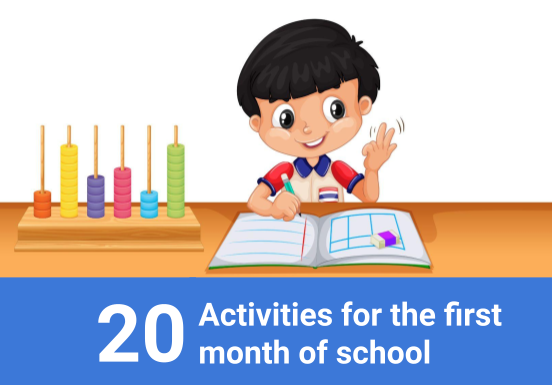
Preparation is key to kicking off the school year to a great start, being in the good graces of your school administration, keeping your stress levels down, and maintaining a great work-life balance.
Since the first month of school is about getting to know your students and allow them to settle into school again, having great activities lined up will help establish the tone for the rest of the year. We’ve compiled a list below of the many activities you can set up for your students while they get to know one another and figure out their team dynamics.
(Note: Most of the activities were designed with elementary students in mind, but many middle and high school students will enjoy them too!)
General Activities
1. Scavenger Hunt. Pair your students up and give them a list of objects to find around the classroom. You can use a scavenger hunt to help familiarize students with the layout of the classroom or to help them find important papers and other supplies they’ll need during the school year. A fun spin on this activity is to have students solve clues that will ultimately unlock a mystery box with a treat inside of it. Depending on the age of your students, the clues can range from mathematical problems, to chemistry questions, anagrams, and more.
2. All About Me. Ask students to bring a photo of themselves to school, or draw a self portrait. Students should write their names clearly and large. This can be pinned up in the classroom so that you and the students can learn everyone’s names easily. A fun extension a few days later is to play a game of “Guess Who” by reading the descriptions of students but hiding the face.
3. A Class Project. If you’ve ever had to pitch a tent, you’ll agree that it’s one of the biggest tests of communication and team work! While you’re not going to go camping in your classroom, you can find other activities that require communication and teamwork, such as constructing a bookshelf, decorating the classroom door, creating a bulletin board or classroom rules poster, or plant a classroom garden. This type of shared activity will help you learn your students’ communication styles and help you all learn to work together. It’s also a great way to spot leaders, and students who shy away from group activities.
4. Find a Friend. After a lot of missed time at school, being in a room full of peers can be intimidating for some students. An easy activity to help break the ice and encourage one on one conversations about shared interests is to create a “Find a Friend” worksheet wherein some interests with pictures are shown, such as hobbies, activities, sports, favorite foods (or worst foods). If two students list ice-cream as their favorite food, have them pair up start talking about the joys of ice-cream – what’s the best brand, topping, spoon or cone, etc. They can then present what they have in common to the class.
5. Bucket Filling. The concept of bucket filling has become popular in many schools. Give each student a plastic bucket to decorate. Talk to students about actions that fill their buckets (being kind, showing respect) and actions that take away from their buckets (not listening, putting others down). Throughout the school year kids can add and take away small stickers, coins, or other tangible objects from their buckets.
Language Arts Activities
6. Readers’ Theater. Take a popular fable or fairy tale and turn it into a readers’ theater piece for the class. Place students into groups and have each group decide how to perform the story for the class. This activity will help students become more comfortable speaking in front of their peers and give them a chance to learn to cooperate with others.
7. Group Writing. Have each student take out a piece of paper and write a sentence or first line of a poem on the top line. Students then pass their papers around the room with each classmate adding a sentence or line. At the end of the activity, every student has a class story or poem to share. Chances are students will think they’re hilarious too!
8. Writing Time Capsule. Give students a traditional back-to-school writing prompt, but add a bit of a twist. Take each student’s piece of writing and place it into a large mailing tube or envelope. Call it a “time capsule” and explain to students that you’ll pull each piece out at the end of the year so they can see how much their writing has improved.
9. My ABCs. Using the 26 letters of the alphabet as inspiration, have students write 26 words or fun facts to describe themselves. They can turn these into small ABC books or simply read them aloud. Use our handy alphabet charts as a template for this activity. You can even emojify this lesson by having students choose five emojis they feel represent them as a person. They should draw these emojis and then explain why, alternatively, the student displays their five emojis to the class and their peers can decipher them.
10. Read a Book. Since the beginning of the school year is so stressful, regularly take some time to sit with students and read a book together. You can let students suggest some of their favorite books to read or choose a fun chapter from the book that the whole class will enjoy.
Math Activities
11. Class Survey. Divide students into small groups and have each group write a summer or back-to-school themed survey question. Each group writes its question and creates a graph for the answers on a large piece of paper hung on the classroom wall. All students then walk around the room and plot their answers on the papers using colored sticker dots.
12. Me by the Numbers. Allow students to blend their artistic talents and math skills with this activity. Give students blank sheets of paper and have them draw pictures of themselves (or use photos) in the middle. Around their pictures, students answer and illustrate number related questions about themselves. For example: How old are you? How many pets do you have? What size shoe do you wear? 
13. Find Someone Who… Bingo. Print a copies of the number-themed Find Someone Who… Bingo cards. Ask students get to know their classmates by talking with each other and writing the initials of the student they find that fits each statement in that box.
14. What’s Your Birthday? Challenge students to arrange themselves in a line across the room in order of birthday (day and month). The catch? No talking or writing.
15. Human Knot. This classic team-building activity also strengthens student understanding of special relationships and pattern recognition. Have 8 – 10 students stand in a circle, raise their right hands, and then join hands with someone across from them. Repeat with left hands. Important – students should be holding hands with two different people and not holding hands with a person next to them. Groups must then untangle the knot without letting go of hands. Try combining students into larger groups after they are successful untying themselves in smaller groups.
Science Activities
16. Lost on the Moon. In this exercise, students must work both individually and together to rank a set of items based upon their importance for surviving on the moon. After, teams can compare their ranking to how experts ranked the items. Get started with this online version.
17. Tower Building. Challenge small groups of students to construct the tallest tower they can using only the materials provided in a given time. Simple materials that work well include straws and paperclips, plastic cups, and index cards.
18. Class Pet or Terrarium. Raising and caring for a pet or growing plants in a terrarium can be a year-long class endeavor that helps foster an appreciation for nature. If your school allows small pets like fish or hamsters, students can work together to develop a job share schedule for feeding, cleaning, and vacation care. Another option is to have students design, build, and care for a class terrarium.
19. Classroom Makerspace. Introduce your students to the concept of makerspaces – a physical location to design, collaborate, and build. Designate an area of your classroom as a makerspace, and have the class brainstorm what should go in the space. Working together to design and create the space will get students excited to use it throughout the year.
20. Two Facts and a Science Fiction. In this variation of Two Truths and a Lie, each student researches two interesting, strange, or amazing science facts and makes-up one science falsehood. Students then take turns sharing their three statements and the class votes on which one is incorrect, or a piece of science fiction.
What activities do you use to help get to know your students and build a sense of community in your classroom at the beginning of the school year? We’d love for you to share them in the comments!
Image source
15 Educational Travel Activities for Kids
- 1 July //
- Posted in For Parents //
- Tags : activities for children, parent resources
- Comments Off on 15 Educational Travel Activities for Kids

If you’re a parent, you know there are very few times you have your kids’ undivided attention. However, when you’re traveling, you have a captive audience. Whether you’re going by plane, train, or automobile, family travel offers an amazing opportunity to connect with your kids and engage them in educational activities. The next time you head off to grandma’s house for Thanksgiving or fly to Florida for vacation, put away the smartphones and tablets for a bit, and try out some of these educational travel activities with your kids.
Toddler – Preschool
“I Spy”
At this age, a key skill for toddlers and preschoolers is being able to take what they’re learning and connect it to the real world. While you travel, you can use the ever-changing landscape to help them make some of those connections. Play a simple game of “I Spy,” but don’t just look for colors. During the game, you can say “I spy…”
- a shape
- a number
- a letter
- a particular animal
Let your kids join in and pick things that they spy too. If they have trouble seeing out the window, then randomly place stickers around the car for them to spy as you drive. You can get reusable stickers if you’re worried about them sticking too much.
Find 100
Another type of seek-and-find game is “Find 100.” In this game, you challenge kids to find 100 of something during the trip. This helps reinforce counting skills. For kids who are just learning to count, you can keep a tally for them or adjust the number to 5, 10, or 20. You can also add in an additional challenge by seeing who can find that number of objects first. Things kids can look for include:
- animals
- shapes
- letters
- items of a certain color
- types of cars
- restaurants
- trees
You can extend the activity by having kids complete a 100 Chart, coloring in the numbers to find a mystery picture.
Virtual Hide and Seek
Toddlers and preschoolers love to play hide and seek, but the game is kind of hard to play in the car. You can, however, play a virtual game of hide and seek where they pretend to hide somewhere in another location and you try to guess where they are. For example, if they pretend to hide somewhere at home, you could say, “I’m looking in the bathtub. Is that where you’re hiding?” If guessing proves impossible, have them give you clues to figure it out.
Motion Games
Kids need to move around, but that’s pretty hard if they’re strapped into a car seat or stuck on an airplane. However, their arms and legs are usually free to wave and kick, so you can take some of their favorite movement songs and adapt them to fit in the car. Some songs that make great car motion games include:
- The Wheels on the Bus
- The Itsy Bitsy Spider
- If You’re Happy and You Know It (change “Stomp Your Feet” to something else)
- Alice the Camel
If you’re traveling for the holidays, you can also look for holiday-themed songs and finger plays that include motions. For example, Five Little Turkeys or Way Up High in the Apple Tree for Thanksgiving and Up on the Housetop or a modified We Wish You a Merry Christmas for Christmas. When you stop for a rest stop, kids can stretch their bodies with a fun movement story.
You will find more road trip activities for preschoolers here.
Elementary
 The Alphabet Game
The Alphabet Game
There are many different versions of the alphabet game. To play you can start off with a phrase, such as:
- I’m going to the store and I need to buy…
- I’m going on a trip and I need to pack…
- I’m going on a trip and I will visit…
- I’m hungry and I’m going to eat…
Take turns adding to the list, letter by letter, repeating all the previous items as you go. At the end, see who can recite the entire list without making a mistake.
License Plate Meanings
License plates are often random combinations of letters and numbers. Pick a random license plate while driving and make up a meaning for the letters and words on the license plate. For example, JCAI26 could be “Just Cruisin’ Along Interstate 26”. You can make the descriptions completely random or try to base them off the type of car or people you see in the car. For more fun, make up a story about the people in the car. What are their names? Where are they going?
Math Quiz
Use the trip as an opportunity to brush up on basic math facts. For younger children, start by stringing addition problems. For example, “What’s 2+2? What’s 4+4? What’s 8+8?” For older children, call out basic multiplication or division problems. If you have multiple children in the car, pull out a stopwatch and see how many problems they can solve in a minute. Use our Worksheet Generator to print out some basic math worksheets before you go.
Twenty Questions
Twenty questions is one of those classic games that kids have been playing for ages. Simply think of a person, place, or thing. Then the other people in the car can ask up to 20 yes/no questions to figure out what it is. You may be surprised how easy it is to figure something out by asking simple questions.
Family Spelling Bee
Who is the best speller in the family? A family trip is the perfect opportunity to find out. Hold a family spelling bee, taking turns spelling words to see who can spell the most words correctly. You can use random words or pick words related to a particular holiday or location. For even more fun, bring along a dictionary and let your children randomly pick out words to see if they can stump you.
All Ages
Listen to a Story
A car or plane trip is a great time to enjoy a good book. If you’re riding in the car, download a novel that the whole family can enjoy and listen to it on your trip. If you can’t find a book to download, bring along a few books to read and take turns reading aloud to the rest of the family. Not only will you get to enjoy a good book, you’ll help your children learn the importance of reading. If you don’t want to read an entire novel, check out funny storytellers, such as Storynory and the Story Pirates podcast.
Tell a Story
Instead of listening to a book or story, you can always make up your own. You can start by making up your own version of a popular fairy tale or embellish a story from your childhood. To get your children involved, tell a story where every person tells one sentence of the story and the others add on to it. If you’re worried you won’t know what to tell a story about, take a look at our writing prompts for some inspiration. You can print out a few to take along on your trip.
Would You Rather?
Would you rather have leaves for hair or mushrooms growing out of your ears? These kinds of silly questions are great for kids of all ages. They teach kids to think creatively and learn how to back up their opinions. If you’re not sure you can come up with questions on the fly, let your kids do the work or just look up a few before you go. Sites with great Would You Rather questions for kids include: ConversationStarters and RRRather.
Listen to Educational Songs
Turn on some music the whole family can enjoy and learn from at the same time. If you have satellite radio, you can listen to a station like Kids Place Live which is full of fun indie music for kids and call-in radio shows for kids, much of which is educational. You can also purchase fun kids’ CDs or download albums full of educational songs. Some good ones that parents will enjoy too include:
- Snacktime! by Barenaked Ladies
- Here Come the ABCs and Here Comes Science by They Might Giants
- A Family Album by The Verve Pipe
- The Best of Schoolhouse Rock or Schoolhouse Rock! Rocks
Road Trip Bingo
Print out or create your own version of Road Trip Bingo to play. As you travel, kids can look for the items on their bingo boards and cross them off as they see them. The first one to get five in a row wins the game. To play the game multiple times, put the bingo boards in plastic sheet protectors and bring along dry erase markers for kids to use to mark each item off. Then you can wipe the board clean in between each game.
How Far Away Is it?
To help make the time go faster, have kids guess how far away different places, landmarks, or rest stops are. For example, if you see a tunnel in the distance say, “How far away is it?” Then watch the odometer to see whose guess was the closest. You can also give kids a map or let them look at the map on a smartphone or tablet to help them figure out exactly how far away a particular landmark is.
These are just a few ways to engage kids in learning activities as you travel during the holidays and year-round. Of course, you can also print out some of your favorite worksheets from Help Teaching and KidsKonnect and put them in a binder for kids to work on during the drive.
Do you have educational activities you enjoy with your kids while traveling? If so, we’d love to hear them. Share them in the comments below.


